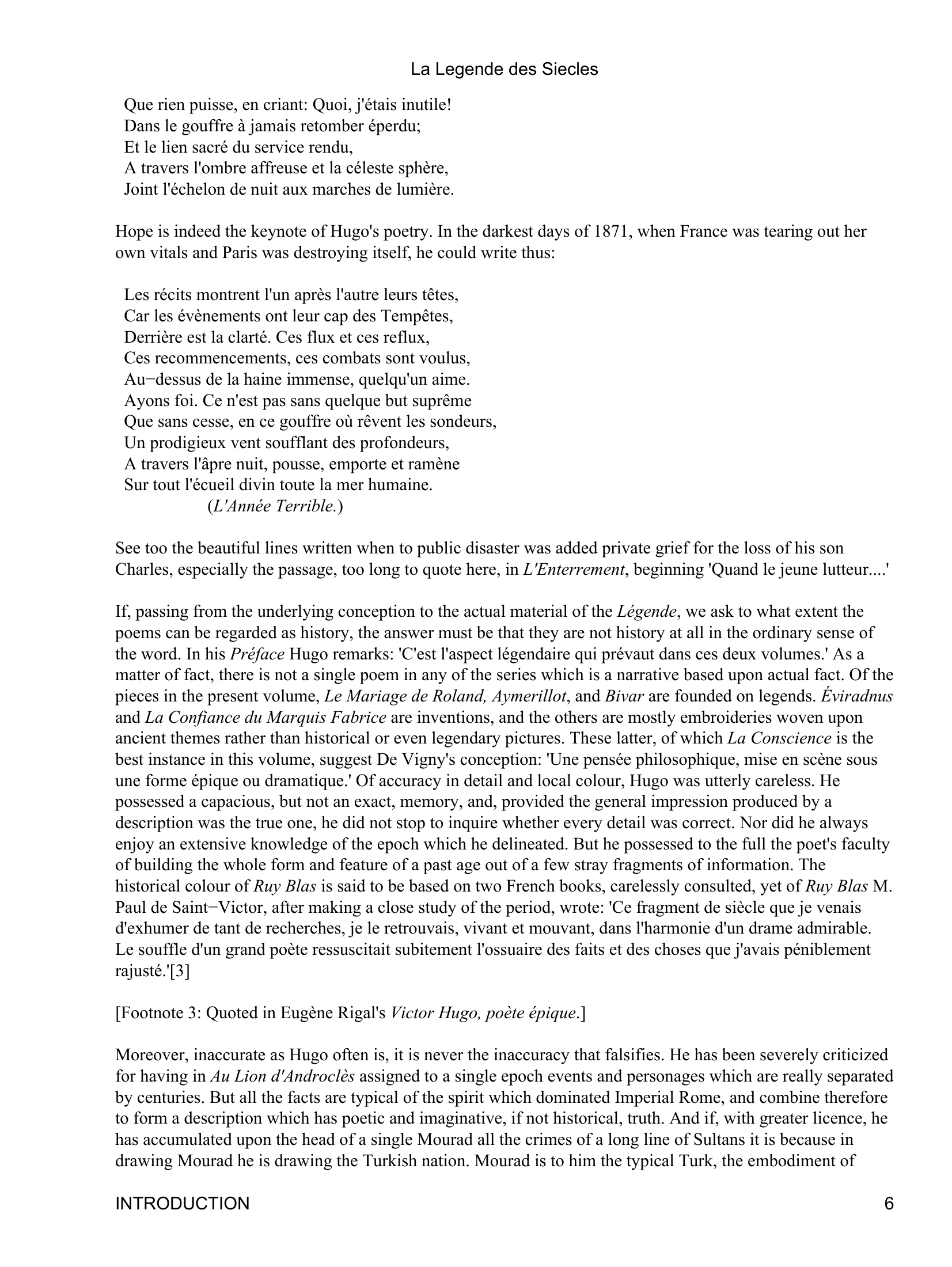La Legende des Siecles Ce livre, c'est le reste effrayant de
Publié le 12/04/2014

Extrait du document
«
Que rien puisse, en criant: Quoi, j'étais inutile!
Dans le gouffre à jamais retomber éperdu;
Et le lien sacré du service rendu,
A travers l'ombre affreuse et la céleste sphère,
Joint l'échelon de nuit aux marches de lumière.
Hope is indeed the keynote of Hugo's poetry.
In the darkest days of 1871, when France was tearing out her
own vitals and Paris was destroying itself, he could write thus:
Les récits montrent l'un après l'autre leurs têtes,
Car les évènements ont leur cap des Tempêtes,
Derrière est la clarté.
Ces flux et ces reflux,
Ces recommencements, ces combats sont voulus,
Au-dessus de la haine immense, quelqu'un aime.
Ayons foi.
Ce n'est pas sans quelque but suprême
Que sans cesse, en ce gouffre où rêvent les sondeurs,
Un prodigieux vent soufflant des profondeurs,
A travers l'âpre nuit, pousse, emporte et ramène
Sur tout l'écueil divin toute la mer humaine.
(L'Année Terrible.)
See too the beautiful lines written when to public disaster was added private grief for the loss of his son
Charles, especially the passage, too long to quote here, in L'Enterrement, beginning 'Quand le jeune lutteur....'
If, passing from the underlying conception to the actual material of the Légende, we ask to what extent the
poems can be regarded as history, the answer must be that they are not history at all in the ordinary sense of
the word.
In his Préface Hugo remarks: 'C'est l'aspect légendaire qui prévaut dans ces deux volumes.' As a
matter of fact, there is not a single poem in any of the series which is a narrative based upon actual fact.
Of the
pieces in the present volume, Le Mariage de Roland, Aymerillot, and Bivar are founded on legends.
Éviradnus
and La Confiance du Marquis Fabrice are inventions, and the others are mostly embroideries woven upon
ancient themes rather than historical or even legendary pictures.
These latter, of which La Conscience is the
best instance in this volume, suggest De Vigny's conception: 'Une pensée philosophique, mise en scène sous
une forme épique ou dramatique.' Of accuracy in detail and local colour, Hugo was utterly careless.
He
possessed a capacious, but not an exact, memory, and, provided the general impression produced by a
description was the true one, he did not stop to inquire whether every detail was correct.
Nor did he always
enjoy an extensive knowledge of the epoch which he delineated.
But he possessed to the full the poet's faculty
of building the whole form and feature of a past age out of a few stray fragments of information.
The
historical colour of Ruy Blas is said to be based on two French books, carelessly consulted, yet of Ruy Blas M.
Paul de Saint-Victor, after making a close study of the period, wrote: 'Ce fragment de siècle que je venais
d'exhumer de tant de recherches, je le retrouvais, vivant et mouvant, dans l'harmonie d'un drame admirable.
Le souffle d'un grand poète ressuscitait subitement l'ossuaire des faits et des choses que j'avais péniblement
rajusté.'[3]
[Footnote 3: Quoted in Eugène Rigal's Victor Hugo, poète épique.]
Moreover, inaccurate as Hugo often is, it is never the inaccuracy that falsifies.
He has been severely criticized
for having in Au Lion d'Androclès assigned to a single epoch events and personages which are really separated
by centuries.
But all the facts are typical of the spirit which dominated Imperial Rome, and combine therefore
to form a description which has poetic and imaginative, if not historical, truth.
And if, with greater licence, he
has accumulated upon the head of a single Mourad all the crimes of a long line of Sultans it is because in
drawing Mourad he is drawing the Turkish nation.
Mourad is to him the typical Turk, the embodiment of La Legende des Siecles
INTRODUCTION 6.
»
↓↓↓ APERÇU DU DOCUMENT ↓↓↓
Liens utiles
- La Legende des Siecles Ce monde est mort.
- La Legende des Siecles L'oeil distingue, au milieu du gouffre où l'air sanglote, Quelque chose d'informe et de hideux qui flotte, Un grand cachalot mort à carcasse de fer, On ne sait quel cadavre à vau-l'eau dans la mer, Oeuf de titan dont l'homme aurait fait un navire.
- La Legende des Siecles C'était de la fureur et c'était de l'extase; Un des enfants revint, apportant un pavé Pesant, mais pour le mal aisément soulevé, Et dit:--Nous allons voir comment cela va faire.
- La Legende des Siecles Et d'Harcourt à prendre Turin.
- La Legende des Siecles La montagne interrompt son crachement de lave, Et le Momotombo répond d'une voix grave: --Je n'aimais pas beaucoup le dieu qu'on a chassé.






